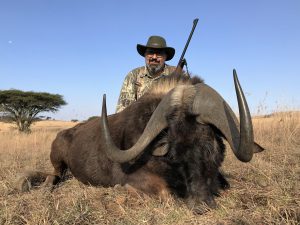South Africa is a large country with many different species, but South Africa has numerous animals that are special. Besides the famous Big 5, we have 5 huntable Antelope that are found in their natural habitat only in South Africa! Let me introduce you to them:
 The Black Wildebeest inhabit open plains, grasslands and Karoo shrub lands in both steep mountainous regions and lower undulating hills. They often share their habitat with Blesbuck and Springbuck. The Black Wildebeest used to be migratory or nomadic and thus were once decimated by farmers who wanted to farm life stock, as they were seen as competition and carriers of diseases. As little as 30 to 40 years ago they were threatened, and their numbers were under 2000! Thanks to Conservation through Hunting, their numbers quickly bounced back and they now thrive on many game farms throughout the Country.
The Black Wildebeest inhabit open plains, grasslands and Karoo shrub lands in both steep mountainous regions and lower undulating hills. They often share their habitat with Blesbuck and Springbuck. The Black Wildebeest used to be migratory or nomadic and thus were once decimated by farmers who wanted to farm life stock, as they were seen as competition and carriers of diseases. As little as 30 to 40 years ago they were threatened, and their numbers were under 2000! Thanks to Conservation through Hunting, their numbers quickly bounced back and they now thrive on many game farms throughout the Country.
Hunting Black Wildebeest will most likely be more successful, if pursued during the early morning or late afternoon while the herd is grazing. The hunter should be very cautious when hunting these animals as they can be extremely aggressive when mating, disturbed or wounded. Always use a heavier calibre as these animals are tough for their size!
In the higher areas of Southern Africa (1000m above sea level and up), you will find the

Grey Rhebok (Vaal Rhebok). They typically inhabit grassy and montane habitats. The “Vaalie” is territorial and maintains its territory by urinating and defecating in the area, standing or walking in an upright posture and patrolling.
The “Vaalie” is part of the tiny ten and is one of the most difficult antelope to hunt in South Africa. It has amazing eyesight, protecting its group of females and occupying mountainous open terrains. Its fur is unique, fluffy and woolly, to be compared with a rabbit or a Chinchilla, this is to help it keep warm in the higher colder parts of the country. Hunting this animal is a true test of skill, patience and shooting ability. Early morning and late afternoon can be considered the best time for hunting Grey Rhebok.
The Cape Grysbok is a small antelope that is endemic to the Western Cape region of South Africa. Its habitat is the Fynbos Biome and inhabits thick shrubland. Sometimes they can be found browsing in orchards and vineyards and may also be found in reed beds and along the riverbed of the Southern Karoo.
 Cape Grysbok are usually hunted at night as they are nocturnal. They can be hunted at daybreak along the edges of dense vegetation, therefore the hunter needs to be in position before light starts breaking. This striking, unique little antelope is part of the tiny ten and makes a beautiful full mount Trophy.
Cape Grysbok are usually hunted at night as they are nocturnal. They can be hunted at daybreak along the edges of dense vegetation, therefore the hunter needs to be in position before light starts breaking. This striking, unique little antelope is part of the tiny ten and makes a beautiful full mount Trophy.
 In the open fields of South Africa, Blesbuck are found in grasslands, close to water. They occupy small territories of 2.5 to 6 acres in size. Blesbuck are mostly hunted on the open plains of the Free State and the Karoo, however they are now found everywhere in South Africa. They are not overly nervous animals and are quite easily shot, sometimes at some distance on the plain. Blesbuck are one of the most popular species amongst hunters coming to South Africa for the first time, as they are affordable and numerous on most hunting areas.
In the open fields of South Africa, Blesbuck are found in grasslands, close to water. They occupy small territories of 2.5 to 6 acres in size. Blesbuck are mostly hunted on the open plains of the Free State and the Karoo, however they are now found everywhere in South Africa. They are not overly nervous animals and are quite easily shot, sometimes at some distance on the plain. Blesbuck are one of the most popular species amongst hunters coming to South Africa for the first time, as they are affordable and numerous on most hunting areas.
 The Bontebok is an Antelope occurring in the Fynbos and Renosterveld areas of the Western Cape, South Africa. Once considered to be the rarest antelope in the world, Conservation through Hunting has ensured its survival. Today the Bontebok is only found in protected areas.
The Bontebok is an Antelope occurring in the Fynbos and Renosterveld areas of the Western Cape, South Africa. Once considered to be the rarest antelope in the world, Conservation through Hunting has ensured its survival. Today the Bontebok is only found in protected areas.
The Bontebok is listed under Cites 1, which requires both export and import permits. Be sure that proper permits are available and secured prior to your hunt.
Use good quality bullets when hunting African game, and if hunting the plains, remember that your shots might have to be made over a considerable distance. Become comfortable shooting from shooting sticks as 80% of your shots will be from sticks. Remember “aim small, miss small”.
Umdende Hunting Safaris specialises in hunting these 5 antelope and we look forward to hosting you on your next hunt in South Africa.






